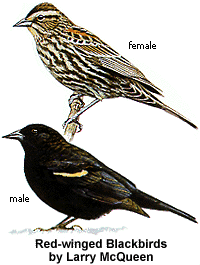Red-winged Blackbird..
(Agelaius phoeniceus)
Cool fact: Perhaps the most abundant North American bird, and certainly one of the most studied, is the Red-winged Blackbird, which is also one of the most highly polygynous of all bird species. In northern and northeastern North America, males that have successfully claimed territories mate with 2 or 3 females; in dryer regions, where marsh insects may be more plentiful, the usual ratio is 3 to 6 females per territorial male. Up to 15 females have been observed on the territory of a single male, but the territory owner may not necessarily father all of the young on his territory. Females sometimes mate with several partners during a season or even during a single nesting attempt.

Although they will also nest in hayfields, swamps, and other wet upland habitats, Red-winged Blackbirds are primarily associated with freshwater marshes. This blackbird's breeding range extends from northern Canada to Central America. Some populations in the southern parts of the range are nonmigratory, but almost all northern birds winter in the South, forming huge flocks that migrate by day, foraging for grain and seeds in fields with other blackbirds, and roost at night in dense cover in wetland habitats. In late summer and fall, they may cause damage to crops such as corn, sunflowers, and rice, as they switch from a summer diet of mostly insects. Winter roosts can be huge, especially in major grain-producing areas in California, Washington, the Southeast, and south-central regions of the United States.
In the fall, migrating males leave after the females and are first to return in the spring to set up territories. Males don't breed until they are two years old, and they must secure and defend a territory to mate successfully. Their courtship displays and territorial defenses are identical: they spread their tail and wings, raising their scarlet epaulet feathers, and sing their familiar oak-a-lee song. This display is sometimes given in flight. At other times, the red epaulets remain covered to avoid conflict with other males—for instance, with a trespassing male or if the male is in the early stages of establishing his territory. Red-winged Blackbirds are fierce defenders of their nests, harassing hawks, crows, and other large birds that pass over and escorting human intruders through their territories, hovering close and making angry calls.
Territorial singing subsides in late July or early August as the young leave the nest. At this time, Red-winged Blackbirds start foraging in fields in large flocks separated by gender, although both sexes mix with other foraging blackbirds and starlings. They return in most areas to the marshes to roost for the night. In August, the birds become more secretive and remain hidden in the marshes during the vulnerable time when they undergo a molt prior to migration.
Description: Red-winged Blackbirds are somewhat smaller than an American Robin (approximately 7.5 to 9.5 inches in length). Males are glossy black everywhere except on the epaulets, or shoulders, of the wing. The epaulets are scarlet (the lesser wing coverts) bordered with a buff or yellowish color (the greater wing coverts). A California subspecies, the "Bicolored Blackbird," lacks the yellowish epaulet margins altogether. The bill, eyes, and feet are black.
Females are blackish brown above streaked with buff and chestnut. The head is streaked with a buffy supercilium, brown cheeks, and dark eye stripe and cap. The throat is pale with a pink or buffy tinge; breast and belly are whitish with heavy dark streaking. The tail and wings are dark brown; the wing feathers are tipped with buff, and there is a trace of the male's red epaulet coloring.
Red-winged Blackbirds do not completely attain full adult plumage until their third year. Immature males are highly variable in appearance, from brown female-like birds with streaked breasts to almost-all-black birds with brown flecks and reddish orange epaulets with dark spotting. The dark lustrous adult plumage is produced by wear, as the flecking is gradually lost. The plumage maturation of females is likewise delayed. Third-year-plus females have a variable amount of color in the throat area—from pink to buff-colored—and on their epaulets, from dull orange to bright red. Second-year females are less variable in color, with light pink faces and throats and salmon to brown epaulets.
Male Red-winged Blackbirds are unmistakable in all parts of the country, except in central and northern California and southern Oregon, where the similar sister species Tricolored Blackbird (A. tricolor) can be found. This blackbird differs from the red-wing in its tendency to breed in extremely dense colonies and its near-total lack of territoriality. The Tricolored Blackbird's bill is more pointed and thicker at the base, and the male's epaulets are darker (blood red rather than scarlet) with a white border. The females are darker than their Red-winged Blackbird counterparts, with underparts that are completely dark brown except the streaked throat and upper breast.